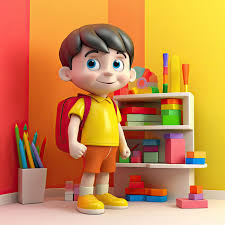In the ongoing quest to nurture well-rounded students, innovative teachers are turning to an unexpected ally: kids animated shows. These colorful programs offer more than entertainment—they serve as powerful vehicles for character education, presenting moral dilemmas, ethical choices, and prosocial behaviors through engaging storylines and relatable characters that resonate deeply with young audiences in ways traditional instruction often cannot match.
The strategic incorporation of kids animated shows into character education allows teachers to harness children’s natural affinity for storytelling and imaginative play. When students see beloved characters demonstrate kindness, perseverance, honesty, and responsibility, these abstract values become concrete and accessible. The emotional connection children form with these characters creates a powerful motivation to emulate positive behaviors, making animated content a natural complement to more direct instruction in character development.
Value-based animated programming has evolved significantly over recent decades. While early cartoons often focused primarily on humor or action, today’s offerings frequently embed sophisticated moral lessons within their narratives. Shows like “Daniel Tiger’s Neighborhood” explicitly teach emotional regulation and social skills, while programs like “Avatar: The Last Airbender” explore complex ethical questions about leadership, responsibility, and conflict resolution. This evolution reflects growing recognition of media’s potential influence on character formation.
Developmental psychologists note that children process moral concepts differently at various stages. Preschoolers typically respond to concrete examples of right and wrong, while older elementary students begin grasping more nuanced ethical considerations. Well-crafted animated programs account for these developmental differences, presenting character lessons in age-appropriate ways that align with children’s cognitive and moral development.
The classroom implementation of animation-based character education requires thoughtful facilitation. Effective teachers don’t simply play episodes and move on—they create structured opportunities for reflection and discussion. Pausing at critical moments to ask, “What choice do you think the character should make?” or “How would you feel in this situation?” transforms passive viewing into active moral reasoning that deepens the learning experience.
Research on narrative psychology suggests that stories shape our understanding of ourselves and our world in profound ways. When children encounter diverse characters navigating moral challenges, they build a repertoire of ethical frameworks and behavioral scripts they can draw upon in their own lives. The narrative structure of animated shows makes abstract values memorable and applicable in ways that direct instruction alone rarely achieves.
Parent-teacher collaboration strengthens animation-based character education. When educators communicate with families about the values being explored through media in the classroom, parents can reinforce these lessons at home. This consistent messaging across environments helps children internalize important character traits and apply them across different contexts in their lives.
Media literacy becomes an important component of this approach. Beyond absorbing the explicit messages in animated content, students can be guided to critically analyze the values being portrayed. Questions like “Whose perspective is missing from this story?” or “What message does this show send about solving problems?” help children become more sophisticated media consumers while developing their moral reasoning abilities.
Cultural responsiveness matters when selecting animated content for character education. The most effective programs represent diverse cultural perspectives and avoid reinforcing stereotypes. Teachers should seek out shows that present universal values while honoring cultural differences in how these values might be expressed or prioritized in various communities.
Classroom culture transforms when values-based animated content serves as a common reference point. Teachers report that shared vocabulary from these programs—phrases like “use your words” or “try and try again”—becomes part of classroom discourse, giving students accessible language to discuss abstract concepts like conflict resolution or perseverance.
The assessment of character development presents unique challenges compared to academic content. However, teachers can observe behavioral changes, invite student reflections on how animated examples connect to their own experiences, or create scenarios that invite application of the values being taught. These approaches provide insight into how children are internalizing important character lessons.
As technology continues evolving, the future of character education will likely include even more interactive approaches to animated content. Virtual reality experiences might allow students to step into ethical dilemmas portrayed in their favorite shows, making decisions and experiencing consequences in immersive environments. These innovations will further bridge the gap between media consumption and character formation.
For today’s educators seeking to nurture both academic achievement and character development, thoughtfully selected animated programming offers a uniquely powerful resource. By leveraging children’s natural engagement with these stories and facilitating meaningful reflection on the values they portray, teachers can cultivate the moral reasoning and prosocial behaviors essential for success in school and beyond.

